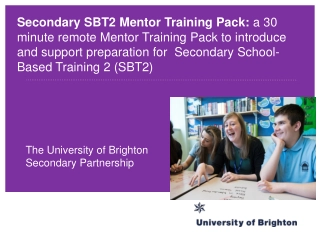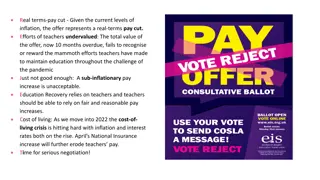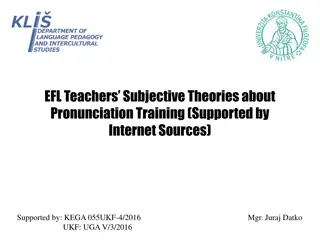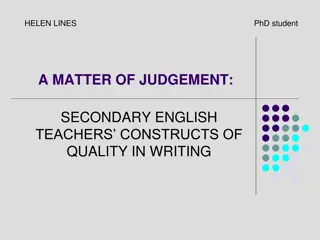
Training Teachers to Assess Productive Skills: Challenges and Strategies
Gain insights into training teachers to assess speaking and writing skills effectively, addressing challenges such as time constraints and feedback, while learning about classroom-based and STANAG 6001 assessments. Discover the importance of formal assessment literacy training for teachers to enhance student learning and motivation.
Download Presentation

Please find below an Image/Link to download the presentation.
The content on the website is provided AS IS for your information and personal use only. It may not be sold, licensed, or shared on other websites without obtaining consent from the author. If you encounter any issues during the download, it is possible that the publisher has removed the file from their server.
You are allowed to download the files provided on this website for personal or commercial use, subject to the condition that they are used lawfully. All files are the property of their respective owners.
The content on the website is provided AS IS for your information and personal use only. It may not be sold, licensed, or shared on other websites without obtaining consent from the author.
E N D
Presentation Transcript
Training Teachers to Assess the Productive Skills BILC Professional Conference - Zagreb 2018 Peggy Garza and Roxane Harrison Partner Language Training Center Europe at the George C. Marshall Center for Security Studies in Garmisch-Partenkirchen, Germany A NATO Partnership Training and Education Center (PTEC) since 2014 NATO Institutional Accreditation since August 2018
Presentation outline Challenges Two different target audiences Teachers who assess speaking and writing in the classroom Teachers who assist STANAG 6001 testers Training plans for each Conclusions
General challenges for teachers Nature of the productive skills Competence demonstrated by performance Time constraints Not enough classroom time for speaking & writing practice and assessment Additional time needed to give individualized feedback on writing Giving feedback Feedback should be timely and meaningful Lack of assessment literacy
Assessing the productive skills: two perspectives Classroom-based assessment (CBA) STANAG 6001 Low stakes High stakes Teachers roles: Teachers roles: Design Develop Administer Assess Assist fully trained STANAG 6001 testers
A good teacher never ceases to assess students, whether those assessments are incidental or intended (Brown 2004) Formal assessment literacy training helps teachers use assessment in an informed way to: Assess students learning and understanding Reveal student strengths / show progress Reveal student weaknesses and learning gaps Target instruction or adapt course of learning Motivate students
Basic training plan for teachers who assess productive skills in the classroom General assessment concepts Testing terminology Test purposes and test types Objective vs subjective testing Formative and summative assessments Assessing speaking Features of speaking Assessment methods Feedback considerations Assessing writing Features of writing Assessment methods Feedback considerations
Achievement testing / proficiency tests Achievement tests Proficiency test / STANAG 6001 Purpose To determine how well students have learnt/mastered the content on a particular course of study. To determine language ability levels, regardless of how language was acquired, based on completing tasks with unrehearsed use of language. Washback Achievement tests are a fundamental part of language training program. Good achievement tests provide positive washback to a language training programs, inspiring teachers and learners alike. In the classroom, STANAG 6001 test practice is possible, but test practice and familiarization is not language instruction. Teaching the test is not possible. This distinction should be part of assessment literacy training for teachers. General assessment concepts
Formative vs summative assessment General assessment concepts
Training Teachers Using classroom-based assessment for speaking and writing Direct vs. indirect testing Authentic use of target language The unique and authentic features of speaking vs writing relate to: Permanence Production time Distance between speaker/listener writer/reader Devices to enhance message orthography vs. stress, intonation, pitch, volume, pausing, gesture, etc. Complexity Formality Vocabulary General assessment concepts
Hallmarks of assessing the productive skills General assessment concepts
Classroom-based assessment for learning Role plays & dialogs Describe pictures Prepared monologs Guided/controlled Bridge between objective and subjective formats Examples Dictation Sentence completion Picture-cued tasks (short answers, descriptions) Extended WRITING Response to prompt or reading assignment Letters, articles, essays, reports, summaries, research papers SPEAKING Retelling stories Oral presentations Summarizing Debates
Alignment of test task & proficiency level Interviews and reports Sentence completion Tasks for Higher Proficiency Levels Panel discussions Picture- cued Q & A Tasks for Lower Proficiency Levels Timed paragraph writing Extended response Anecdotes & narratives Presentations Letter writing LOW Debates Role play dialogs Essay Evidence of learning and Evidence of areas for improvement Evidence of learning and Evidence of areas for improvement
Considerations when giving feedback Peer decisions, decisions, decisions decisions correction Accuracy vs fluency Correction Teacher correction Immediate/ on the spot vs Delayed feedback codes Error correction vs. guided learning Self correction Individualized (targeted) vs Group or class feedback on trends Assessment literate teachers make informed decisions to provide intentional, reasoned feedback Rubrics
Training teachers to rate STANAG 6001 proficiency tests
The importance of training Perform the required task to a common standard gain knowledge of assessment methodology and testing principles reach a common understanding/interpretation of rating scale achieve consistency in the application of the rating criteria minimize tester idiosyncrasies and construct-irrelevant variance follow standardized testing procedures enhance alignment of ratings Increase/maintain professionalism and quality make informed decisions selection and qualification/certification of testers Ensure that the inferences made on the basis of the test results are valid, accurate, and fair
Program for teachers who rate STANAG 6001 speaking and writing tests General testing topics STANAG 6001 speaking tests STANAG 6001 writing tests Training plan Certification process Monitoring and norming program
General testing topics Ensure a common understanding of terminology Familiarization with STANAG 6001 Characteristics of STANAG 6001 testing Test purposes and test types Proficiency tests and techniques Test specifications Uniqueness of testing the productive skills
Training plan for STANAG 6001 raters writing & speaking Training to rate STANAG 6001 tests Familiarization with descriptors, including the plus levels CTA exercises Comparing base levels and plus levels Benchmark tests at base levels and plus levels Clear pass, clear fail and borderline pass and fail tests Practice with rating factor grids Speaking Tests Learn the structure of a speaking test Observe live speaking tests Given prompts and role plays, determine the levels elicited Rating practice Writing Tests Holistic rating: top down vs. bottom up Given prompts, determine the levels elicited Rating practice
Certification process Independent rating of 6 or more tests at various levels, with at least 70% exact agreement with the official ratings and other ratings within a plus level. Statement of confidentiality Statement of confidentiality A statement signed by anyone involved in test administration or rating that they will not reveal the contents of the test nor information about the performance of the test takers. Why is it important? To prevent test compromise To protect the confidentiality of the test takers Test takers should not get specific feedback on their performance
Monitoring and norming program Inter Inter- - and intra and intra- -rater reliability rater reliability Reliability: the extent to which a test yields consistent and dependable results Inter-rater reliability Two or more raters yield consistent scores for the same test Intra-rater reliability Same rater yields consistent scores across all tests Reliability indicators for tests of the productive skills To ensure that the ratings given by the raters are accurate and fair To inform future (re) training and norming Why is this important? Norming Periodic norming sessions with other STANAG 6001 testers/raters
Conclusions Two target audiences/two separate training programs Positive washback Formative assessment ---proficiency building Understanding of STANAG 6001 tests of the productive skills---- proficiency building and proficiency testing Importance of more attention to writing BILC Language Needs Analysis (LNA) findings on writing Productive skills may be challenging to teach and assess, but are key to interoperability






















